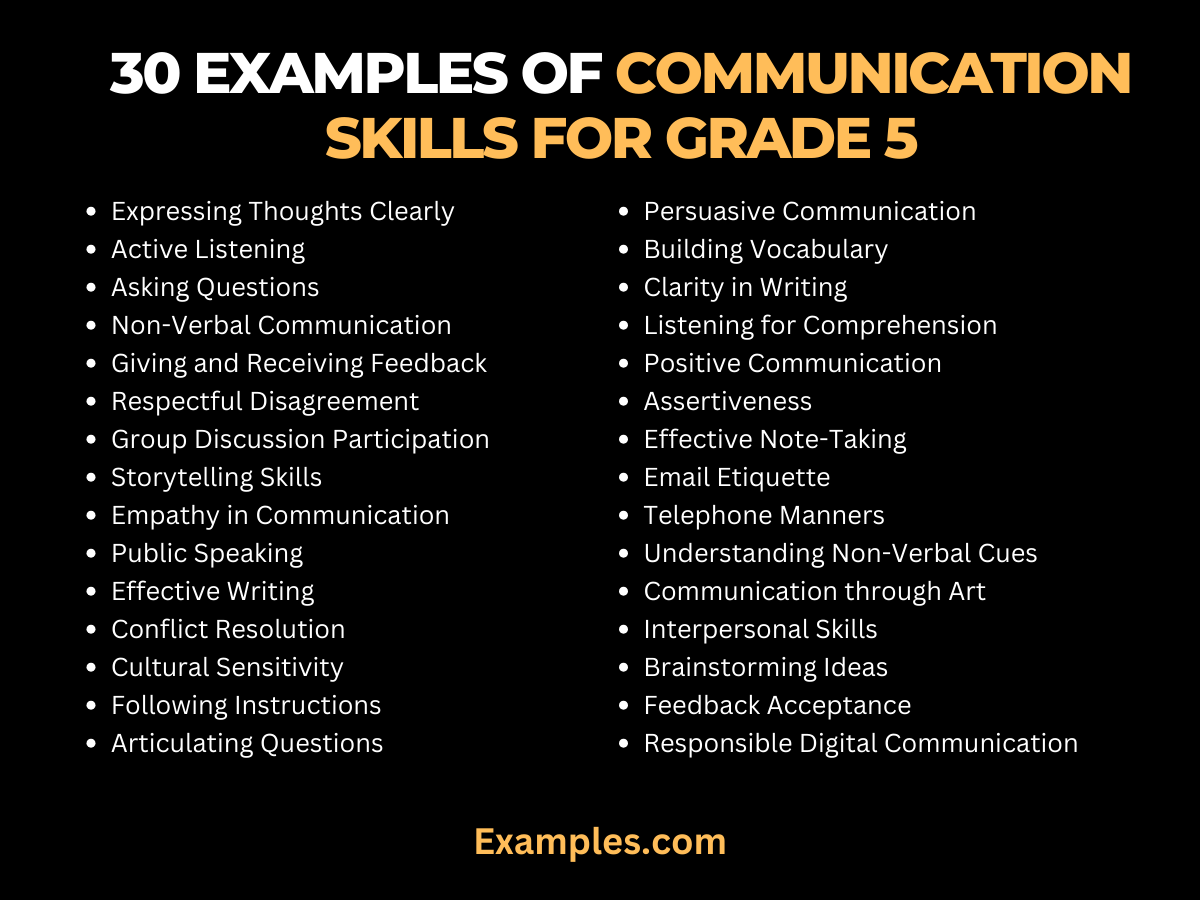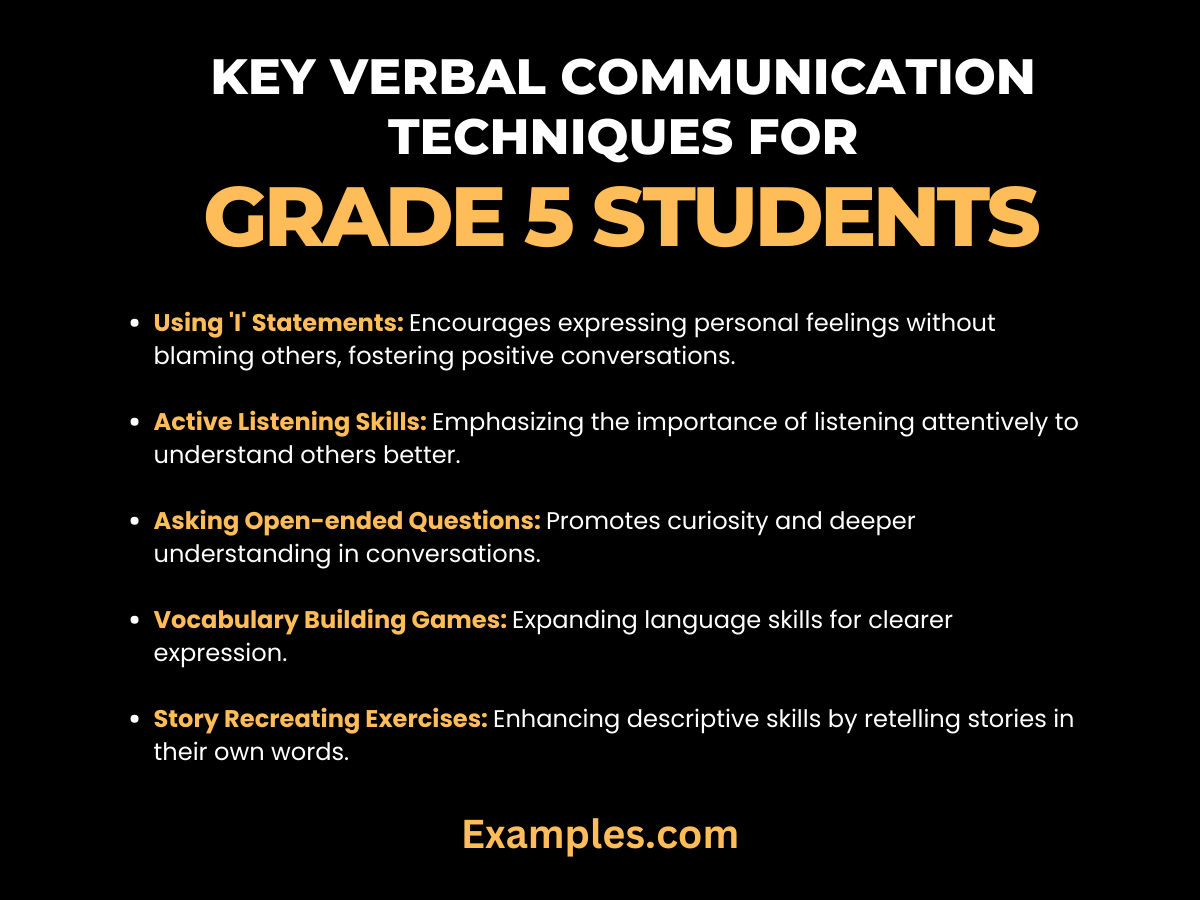29+ Communication Skills for Grade 5 Examples
Developing communication skills in Grade 5 students is a pivotal step in their educational journey, fostering not just academic success but also essential life skills. This comprehensive guide focuses on enhancing various aspects of communication, tailored specifically for 10 to 11-year-olds. Through practical Communication Examples and age-appropriate activities, this guide offers parents and educators effective methods to cultivate listening, speaking, and interpersonal skills among young learners. From building confidence in public speaking to nurturing empathy and active listening, this guide equips you with the tools to help your fifth graders thrive in both classroom interactions and everyday life.
30 Examples of communication skills for grade 5
In Grade 5, students are at a critical phase where developing effective communication skills is key to their academic and personal growth. This guide presents 30 distinct examples of communication skills specifically designed for fifth graders. Each example is crafted to enhance their ability to express themselves, understand others, and effectively engage in various forms of communication. From mastering the art of active listening to effectively participating in group discussions, these examples, accompanied by practical applications, provide a roadmap for educators and parents to foster strong communication abilities in their young learners.

- Expressing Thoughts Clearly: Teach students to articulate their ideas in a clear and concise manner.
Example: Encourage them to share a favorite story and explain why they like it. - Active Listening: Emphasize the importance of listening attentively to others.
Example: Have students summarize what a classmate said during a discussion. - Asking Questions: Encourage curiosity and inquiry.
Example: Prompt them to ask questions after a lesson to deepen understanding. - Non-Verbal Communication: Show how body language and facial expressions convey messages.
Example: Role-play different emotions and identify them through non-verbal cues. - Giving and Receiving Feedback: Teach them to provide constructive feedback kindly.
Example: Peer-review each other’s work and offer positive suggestions. - Respectful Disagreement: Guide them to express differing opinions respectfully.
Example: Debate a topic, ensuring each student speaks courteously. - Group Discussion Participation: Encourage active involvement in group settings.
Example: Organize group projects where each student has a chance to speak. - Storytelling Skills: Enhance their ability to tell stories effectively.
Example: Have a story-telling session where students narrate a personal experience. - Empathy in Communication: Foster understanding and empathy.
Example: Discuss scenarios and ask how they would feel in those situations. - Public Speaking: Build confidence in speaking in front of others.
Example: Conduct a ‘show and tell’ session to practice public speaking. - Effective Writing: Develop writing skills for clear communication.
Example: Write short essays or stories on chosen topics. - Conflict Resolution: Teach strategies to resolve conflicts amicably.
Example: Role-play scenarios where they practice resolving disagreements. - Cultural Sensitivity: Educate on respecting diverse cultures.
Example: Share and discuss traditions from different cultures. - Following Instructions: Practice understanding and following directions.
Example: Give a series of steps for a task and have them complete it. - Articulating Questions: Teach them to ask clear, relevant questions.
Example: In a Q&A session, encourage them to formulate thoughtful questions. - Persuasive Communication: Introduce techniques for persuasive speaking.
Example: Persuade classmates on a topic like the importance of recycling. - Building Vocabulary: Expand their word usage for better expression.
Example: Introduce new words weekly and use them in sentences. - Clarity in Writing: Focus on clear, coherent writing.
Example: Write instructions for a simple game and exchange them to see if they are clear. - Listening for Comprehension: Strengthen listening for understanding.
Example: Listen to a short story and answer questions about it. - Positive Communication: Encourage positive language use.
Example: Practice replacing negative statements with positive ones. - Assertiveness: Teach them to express needs and opinions assertively.
Example: Share opinions on a book or movie confidently. - Effective Note-Taking: Develop skills for taking useful notes.
Example: Take notes during a lesson and share key points. - Email Etiquette: Introduce basics of formal digital communication.
Example: Write an email to a fictional pen pal. - Telephone Manners: Practice polite telephone conversations.
Example: Role-play making a phone call to a friend. - Understanding Non-Verbal Cues: Recognize and interpret body language.
Example: Guess the emotion based on a classmate’s body language. - Communication through Art: Express ideas creatively through art.
Example: Draw a picture to convey a message or story. - Interpersonal Skills: Develop skills for one-on-one interactions.
Example: Pair up students for a discussion on a topic. - Brainstorming Ideas: Encourage collaborative idea generation.
Example: Group brainstorm for a class project. - Feedback Acceptance: Teach how to accept feedback gracefully.
Example: Discuss how to respond constructively to critiques. - Responsible Digital Communication: Educate on respectful online communication.
Example: Discuss the dos and don’ts of internet etiquette.
Effective Social Communication Lessons for Grade 5 Students
Social communication is vital for children’s development. Engaging Grade 5 students with lessons that enhance their social communication skills can significantly boost their confidence and interaction abilities. Here are 10 unique examples:
- Role-Playing Different Scenarios: Students act out various social situations, learning how to navigate conversations and understand diverse perspectives.
- Group Discussions on Current Events: Encourages students to express their opinions and listen to others, fostering respectful dialogue.
- Storytelling Sessions: Sharing personal stories in a group, enhancing empathy and understanding among peers.
- Debate on School Topics: Helps students articulate their thoughts clearly and respectfully disagree.
- Team Building Activities: Engages students in tasks requiring communication and collaboration, emphasizing teamwork.
- Communication Games: Like ‘Telephone’ to demonstrate how messages can change, highlighting clear articulation.
- Emotional Charades: Recognizing and expressing emotions through non-verbal cues, enhancing emotional intelligence.
- Peer Feedback Sessions: Students learn to give and receive constructive feedback, improving interpersonal interactions.
- Social Media Etiquette Class: Teaching responsible online communication, relevant in today’s digital age.
- Cultural Exchange Projects: Exposing students to different cultures, promoting inclusivity and global awareness.
Key Verbal Communication Techniques for Grade 5 Students
Mastering verbal communication is crucial for young learners. Grade 5 students can benefit from these 10 examples of key verbal communication techniques:

- Using ‘I’ Statements: Encourages expressing personal feelings without blaming others, fostering positive conversations.
- Active Listening Skills: Emphasizing the importance of listening attentively to understand others better.
- Asking Open-ended Questions: Promotes curiosity and deeper understanding in conversations.
- Vocabulary Building Games: Expanding language skills for clearer expression.
- Story Recreating Exercises: Enhancing descriptive skills by retelling stories in their own words.
- Public Speaking Practice: Boosting confidence in expressing thoughts in front of an audience.
- Role-Playing Interviews: Preparing for real-life scenarios like interviews, improving formal communication skills.
- Poetry and Rhyme Sessions: Encourages creative expression and rhythm in speech.
- Peer Discussion Circles: Small group discussions on varied topics, promoting dialogue skills.
- Feedback Loop Practice: Learning the art of giving and receiving feedback, an essential part of effective communication.
Group Communication Activities for 5th Graders
Engage 5th graders with dynamic group communication activities, enhancing teamwork and verbal skills. Activities like role-playing, group discussions, and collaborative projects foster effective communication skills and soft skills communication among young learners. These interactive exercises cultivate listening in communication skills, empathy in communication skills, and collaboration in communication skills, essential for their academic and social development.
- Team Storytelling Relay: In this activity, students form groups and collaboratively create a story. Each member adds a sentence, practicing storytelling as communication skill and active listening in communication skills.
- Opinion Sharing Circle: Students sit in a circle and share opinions on various topics, enhancing their interpersonal communication skills and respect for diverse perspectives.
- Group Puzzle Solving: Each group receives a puzzle to solve together. This activity promotes collaboration in communication skills and problem-solving as a team.
- Role-Play Scenarios: Groups enact given scenarios, like a news report or a historical event, boosting their presentation skills in communication and creativity.
- Debate Club: Students engage in friendly debates on light topics, developing their persuasion in communication skills and critical thinking.
- Emotion Charades: Here, students act out different emotions while others guess, enhancing their emotional intelligence in communication skills and empathy.
- Feedback Fishbowl: After completing a group task, students give constructive feedback, fostering feedback in communication skills and self-awareness.
- Classroom Conflict Resolution: Groups discuss hypothetical conflicts and propose solutions, highlighting the importance of conflict resolution in communication skills.
- Joint Story Writing: Groups write a story together, each contributing a part. This exercise hones written communication skills and collective creativity.
- Community Project Planning: Groups plan a mock community project, practicing communication skills for project management and organizational abilities.
How Grade 5 Students Improve Communication Skills?
In the journey of academic and personal growth, mastering communication skills is crucial for Grade 5 students. This comprehensive guide delves into practical strategies and activities that can significantly enhance these skills in young learners, laying a foundation for their future success.
Understanding the Basics of Communication
The first step in enhancing communication skills is understanding its basics. Communication is not just about talking; it involves listening, understanding, and expressing thoughts clearly. Grade 5 students should be taught the importance of communication skills in everyday life. Lessons on types of communication skills—verbal, non-verbal, and written—provide a solid foundation.
Encouraging Active Listening
Active listening in communication skills is vital. Students should be encouraged to listen attentively, ask clarifying questions, and repeat back what they’ve heard to ensure understanding. This not only improves their listening skills but also helps in better comprehension of the subject matter.
Fostering Empathy through Communication
Empathy in communication skills plays a crucial role in how students interact with peers and teachers. Role-playing exercises can be an effective way to develop empathy, as students put themselves in others’ shoes and understand different perspectives.
Developing Verbal and Non-Verbal Skills
Both verbal and non-verbal cues are important in effective communication. Grade 5 students can benefit from exercises that focus on clear articulation, proper tone of voice, and appropriate body language. Drama and public speaking activities are great ways to enhance these skills.
Enhancing Written Communication
As students advance in their education, the importance of written communication skills becomes more evident. Encouraging regular writing practices, such as journaling or story writing, can significantly improve their ability to express thoughts in writing.
Integrating Technology in Communication
In today’s digital age, understanding the positive & negative effects of social media communication skills is important. Teaching students about digital communication etiquette and the impact of their online conversations is vital.
Regular Practice and Feedback
Frequent practice is key to mastering communication skills. Classroom activities that involve group discussions, presentations, and debates offer ample opportunities for practice. Additionally, providing constructive communication skills feedback is essential for improvement.
Parent-Teacher Collaboration
Communication skills for parents and teachers in supporting the child’s learning journey are pivotal. Regular parent-teacher meetings and discussions about the child’s progress can ensure a supportive environment for developing these skills.
Setting Personal Goals
Having students set personal goals for communication skills can be a motivating factor. These goals can range from improving their participation in class discussions to being more effective in group projects.
Using Resources and Tools
Various resources, such as communication skills books and online materials, can provide additional support. Teachers can incorporate these resources into their lesson plans for a more engaging and comprehensive learning experience.
In conclusion, Developing effective communication skills in Grade 5 students is not just beneficial for their current academic achievements but also lays the groundwork for their future personal and professional success. As they navigate through the complexities of adolescence and prepare for middle school, the ability to communicate effectively becomes increasingly important. It’s essential for parents and educators to continue fostering these skills through diverse activities and real-world applications. For further reading, the American Speech-Language-Hearing Association offers valuable insights into the development of communication skills in children, including practical tips and resources.
Additionally, the role of technology in communication cannot be overlooked. In today’s digital age, teaching students about digital literacy and online communication etiquette is crucial. This includes understanding the impact of their digital footprint, learning to communicate respectfully online, and navigating the vast array of digital communication tools responsibly. For more information on this topic, Common Sense Education provides comprehensive resources on digital citizenship and safe online communication, which can be incredibly beneficial for educators and parents guiding children through the digital landscape.
By embracing these resources and continuously adapting teaching methods to meet the evolving communication needs of Grade 5 students, we can ensure that they are well-equipped with the necessary skills to thrive in both their academic and personal lives.



